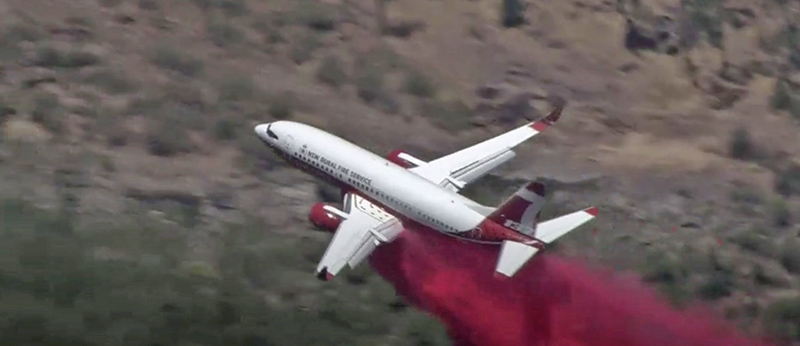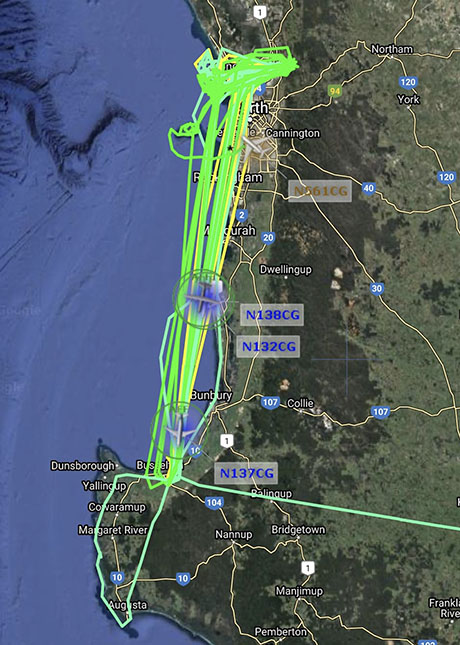
One more large air tanker was flown across the Australian continent, over 3,000 miles, to assist with the bushfire that has burned 10,579 hectares (26,133 acres) northeast of Perth in Western Australia. The Coulson 737 joined the NSW RFS 737 and a Coulson C-130 that had been working the fire, bringing the fleet of large air tankers temporarily in Western Australia up to three.
For the first time, a large air tanker, a C-130, has been based in Western Australia for most of the entire bushfire season. During the 2019-2020 bushfire season an Erickson MD-87 was deployed in the state for 45 days.
At least 81 homes have been destroyed in the blaze.

More information about the bushfire northeast of Perth.
The article was edited to show that a large air tanker was deployed in Western Australia for 45 days in the previous bushfire season.

My mistake. The above article was from 2020.
We had Scoopers available and tried to secure a contract but we never got the call the call to come.
With the fire being in such close proximity to the water a few Scoopers is what is really needed.
The Canadian Scooper has not migrated to Aus this year, so far.
https://www.abc.net.au/news/2020-01-16/bushfire-fighting-planes-unable-to-get-to-australia-from-canada/11871384
Air tankers are impressive to watch, and are effective under certain conditions. The media tends to exaggerate their use. Many times, aircraft can’t get into areas, including sub-divisions because of smoke. In your case, they may have been able to drop ahead of the fire with sufficient visibility, and later, when the fire approached the homes, the combination of increased humidity, cooler night time temperatures and retardant (and I’m sure, ground resources) helped to keep the structures from burning.
You’ve described what happened quite accurately, Jeff. My post was to point out that the retardant by itself did not save the urban subdivision from disaster, as the media want us to believe.
I have no data on the night but one TV news showed video of the urban area ‘protected’ by the retardant on the night as the fire front approached and wind speeds were very low. My claim about higher humidity at night is based upon the general acceptance that humidity rises as temperature falls, plus there were extensive thunderstorms north and east of Perth at the time and they were dropping very large amounts of rain, so extremely humid air was reasonably close by and likely contributing moisture to the incoming winds.
DFES and the media are touting the use of these planes and the retardant line they laid down as having ‘saved’ a suburb from destruction. The truth is however a little different. The fire was approaching the suburb at night when humidity was higher than during the day and that night’s wind conditions were much less strong or gusting than the previous day. So, while the retardant helped, the suburb was saved more by as more humid night and more favourable weather.
I remain quite skeptical of the value of these large aerial tankers and their ability to stop fires under severe weather conditions or when the fire is burning in dense vegetation.
What were the humidity percentages during the day and night, Bernie? Got night and day wind speeds too?
Perhaps this long overdue AFUE air tanker use and effectiveness study by USFS/USDA released last year will answer some of your questions. https://www.fs.usda.gov/sites/default/files/2020-08/08242020_afue_final_report.pdf
See probability of success and % of favorable drop outcomes by type of tanker.
Bean
Thanks for the link to this very interesting report.
Interesting!!
Bernie,
Tankers don’t stop fires. Tankers apply retardant, which by definition, RETARDS fire, or slows its progress, to effect the tactics established by the incident commander. A fast moving, wind driven fire exceeds the capability of man to stop. We can fight them by modifying their behavior, changing their direction robbing their fuels, driving them into natural barriers, and a host of other tactics, including burning out fuels in advance of the fire.
The purpose of the tanker is to apply retardant. That’s it.
On occasion, tankers do put out fires, spot fires, lines, flanks, or box them in, cut them off, or alter their progress in dramatic fashion. Most of the time, tankers are putting down retardant to support ground troops, or working areas inaccessible due to personnel numbers, terrain, or time. Sometimes fire burs through retardant, sometimes spots over it, sometimes stops, sometimes simply slows.
The tanker is a “tool in the toolbox,” as is often said.
The alternative to air support is to do without. I don’t recommend it.
Thanks for the comment, Doug. I’m sure large aerial appliances have their place in firefighting or fire retarding. However, here in WA, the media is convincing the public that such tankers put out fires far more effectively than anything else, including on-ground fire teams. Politicians love such appliances because it takes the public’s mind off the issue of reducing fuel loads which, in my view, must be the primary tool in the fire prevention and mitigation toolbox, after which helicopters come second (see the US Dept of Agriculture report from March 2020 referred to me by another respondent on this page) and then large tankers etc.
Bernie,
I appreciate the context, especially as a former resident of Oz, myself (with fond memories). I’ve been through a few bush fires there. The politics vs. the actual firefighting are quite different, as is the difference between paying and fighting fire. Politicians deal with public fallout, and the budget, in the context of cost per gallon and the “optics,” while the firefighter’s view is more simplistic: the problem of tactics, effectiveness, and survival in the context of heat, energy spent, ground lost, and success. From an individual firefighter’s point of view, I don’t agree with the Dept of Ag report, which is tempered by factors other than efficiency and effectiveness. Helicopters are important tools, of course, and have multiple uses on a fire, whereas fixed wing tankers have just one or two…but helicopters will never lay down the amount of retardant/fireline as fast, as heavily, as long, or as effectively as fixed wing tankers. Fixed wing tankers are effectively one-trick ponies, whereas helicopters are multi-role vehicles; apples to oranges, but both valued resources over the fire. The other issue to which you referred is clearing brush. Australia has far fewer resources, especially relative to the acreage involved, than the US: the US has nowhere near the manpower needed to vacuum and prune the forests. It’s wildland. There’s only so much that can be done. Individuals and communities need to do the rest with defensible space and planning. Fires burn and will continue to burn with forces well beyond the scope of mankind’s capability to suppress, and the forests and wildlands are far too vast and extensive to tidy up and clean, to prevent fire or prevent intense fire. It will happen, and always has. When it does happen, fixed wing tankers on hand are not a bad thing to have.
Thanks again for your comments, Doug. I have no problem accepting the need for fixed wing tankers to be part of the fleet of aerial firefighting appliances for the reasons you outline. The problem here in Australia is that the media is influencing the public to believe that we only need tankers, and all other resources including helicopters and on-ground fire crews can be dispensed with or remain at their current resourcing levels. Their logic extends into believing that you don’t need fuel reduction burns as tankers will either put out fires burning in high fuel loads or will lay down a totally protective band of retardant to protect human assets from the fire front, ignoring the fact that it is the ember attack which generally burns down houses and other infrastructure.
As an ex-politician myself, I try to respond to popular media campaigns by presenting facts from authoritative reports such as the 2020 US Dept of Agriculture report to point out to the public that politicians and governments and the media often cannot be trusted to present important or useful facts etc.
IM ALWAYS LOOKING FOR THE D.C.910 SUPER JET ASI HAVE SEEN IT IN ACTION MANY TIMES THAT AIRCRAFT I JUST LOVE IT. IS IT STILL IN USE OR IS IT RETIRED. ALLEN MOSER am********@ao*.com
DC-10s Are still very much in use. Four are currently outfitted as air tankers and most likely will be in the sky this spring, summer, and fall. And, I hope you are able to get that pesky stuck caps lock key fixed.